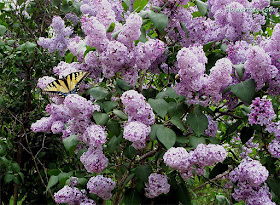Lilac (Syringa vulgaris) blossoms are classic signs of spring. However, not all lilac shrubs bloom to their expected potential. Some factors that influence blooming are out of our control. A late frost is often the culprit along the Colorado Front Range, freezing delicate buds before they have a chance to open. All we can do in those years is cross our fingers and hope next spring is better. Changes in the environment around the lilac can affect blooming.
Sometimes these are gradual changes, such as a neighboring tree getting larger over the years and shading the lilac. Other changes are sudden, like disrupting the roots of the lilac with construction in a nearby area. Lilacs can also be infested with pests, namely oystershell scale (Lepidosaphes ulmi Linnaeus)) and lilac borers (Podosesia syringae (Harris)). These pests gradually build up over time, decreasing the vigor of the bush. The numbers of pests are greatest on the oldest stems of the lilac shrub. The best way to manage these pests is through pruning. Without routine pruning, even if no pests are present, quantities of blossoms on a mature lilac will decrease naturally.
Lilacs are spring-flowering shrubs. This means buds develop on one-year-old wood grown during the previous summer and fall. Over time, unpruned lilacs become woody and produce less new growth for flower bud development. The center of the bush becomes shaded and few blooms or leaves grow there. Ideally, a lilac bush needs a mix of young new shoots and older stems to have foliage and blooms dispersed throughout the bush.
To maximize next season’s flowers, pruning should occur after the bush has bloomed in May, but before the new buds have grown in July. If the shrubs are trimmed in the fall or winter, the flowering wood and its buds are removed, decreasing the amount of blossoms in the spring. The first step to maintain a lilac shrub is to “deadhead” or remove the spent blooms. This conserves the plant’s energy that would have otherwise been spent on seedpod and seed development. Once deadheading has been accomplished, prune the bush to have a mix of stems ranging from pencil thickness to 1 or 2 inches in diameter. Remove stems that are greater than 2 inches in diameter. Cut stems near the ground. Do not remove more than one-third of the stems each year to conserve enough wood for growth that will produce next year’s blooms. Shape the bush while pruning.
If a large, well-established lilac shrub has become unruly and unproductive, rejuvenating pruning may help the plant blossom more fully. With this method, the entire shrub is cut to a height of 6 to 8 inches in the early spring. The shrub will regrow from the roots as a smaller, softer plant with a more youthful appearance. In the years following rejuvenating pruning, the new stems should be trimmed to select the strongest individuals. Keep in mind two caveats with rejuvenating pruning. The lilac bush will not bloom at all in the year following the pruning, but blooming should be abundant in later years. Also, this method is only appropriate for “old-fashioned” or common lilacs. Special cultivars grafted on to common lilac rootstock will grow back as common lilacs if pruned below the grafting site, losing their unique characteristics.
For more information on lilac maintenance and maximize lilac blooms, please visit the following websites:
